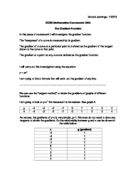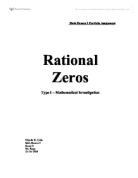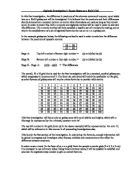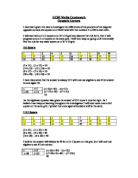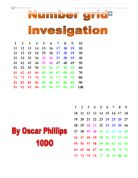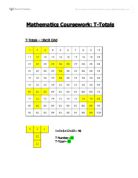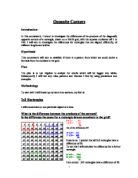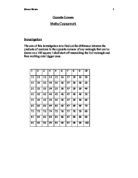Maths Coursework- Borders
Joanna Burton 10s 23rd June 2004 Maths Coursework- Borders QUESTION Figure below shows a dark cross-shape that has been surrounded by white squares to create a bigger cross-shape; The bigger cross-shape consists of 25 small squares in total. The next cross-shape is always made by surrounding the previous cross-shape with small squares. Part 1- Investigate to see how many squares would be needed to make any cross-shape built in this way. Part 2- Extend your investigation to 3 dimensions. Introduction - I am doing an investigation to see how many squares would be needed to make any cross-shape built up in this way. Each cross-shape is made by using the previous cross-shape and adding another layer of white squares, making all the inner squares black. The first cross-shape in the sequence is a single black square. To start my investigation I must draw the first 7 cross-shapes. This will enable me to see a pattern in the shapes so I can make a table and record how many black and white squares there are in each cross-shape I have drawn. From my table I must use the results to work out formulae for black, white and total number of squares. After this I will test the formulae on a pattern I have already drawn and on one I have not already drawn. I will be working systematically in my investigation
T-totals, Relationships between the T-number and the T-total on a 9 x 9 grid.
Mathematics GCSE T-totals Alex Pavlou ). Relationships between the T-number and the T-total on a 9 x 9 grid. 2 3 4 5 6 7 8 9 0 1 2 3 4 5 6 7 8 9 20 21 22 23 24 25 26 27 28 29 30 31 32 33 34 35 36 37 38 39 40 41 42 43 44 45 46 47 48 49 50 51 52 53 54 55 56 57 58 59 60 61 62 63 64 65 66 67 68 69 70 71 72 73 74 75 76 77 78 79 80 81 82 83 84 85 86 87 88 89 90 T-totals T-numbers 21 42 26 67 42 47 66 267 80 337 86 367 The difference in each T-shape is: N-19 N-18 N-17 N-9 N If we take the T-shape: 2 3 4 12 21 we can create the sum: t=21+(21-9)+(21-19)+(21-18)+(21-17) As there are 5 numbers in the T-shape we need 5 lots of 21, the number above 21 is 12, which is 9 less than 21, the other numbers are 2,3 and 4 which is 9 less than 21. Therefore we arrive to the conclusion: N-19 N-18 N-17 N-9 N To prove this we use the T-shape: 61 62 63 71 80 T=80-19+80-18+80-17+80-9+80 T=337 We can do the same for the T-shape: 47 48 49 57 66 T=66-19+66-18+66-17+66-9+66 T=267 To find the formula of the relationship between the T-number and the T-total we use N for the T-number. T=N+(N-9)+(N-19)+(N-18)+(N-17) T=5N-9-54 T=5N-63 Examples of this formula are : In the case of the T-shape: 52 53 54 64 71 T=5(71)-63 T=355-63 T=292 When we add the
T-Total Maths coursework
In this coursework I am going to investigate the relationship between T-numbers and T-totals. I will find the relationship between T-number and T-totals by looking at the pattern of the sequence, which goes up by 5 each times when you add the T-total with 5. I will use grids of different size and will translate the T-shape into different positions in order to examine the correlation between them. The T-total and T-number will be translated onto different positions such as 900 clockwise. After the translation of T-total and T-number, I will find the formula that will be devised by putting a careful scrutiny on the pattern of my T-numbers. Aim: The aim of this investigation is to find a relationship between the T-total and T-numbers, but in this case the T-shape can be positioned in different ways, for example upside down or side ways. As the T-shape can also be changed a relationship between the transformations also has to be found. Method: I will first draw out a 9 by 9 grid and put T-shape within it first placing them upside down, then side ways on the right and then also on the left. I will place my results into a table and attempt to find a relationship between the T-total and T-number as I did before. I will incorporate this relationship into a rule using letters and numbers only. I will then do a similar thing for 8 by 8 grids and 7 by 7 grids. In this
Investigating T-shapes.
Investigative Maths Coursework We looked at a T-shape drawn on a nine width grid like this: 2 3 4 5 6 7 8 9 0 1 2 3 4 5 6 7 8 9 20 21 22 23 24 25 26 27 28 29 30 31 32 33 34 35 36 37 38 39 40 41 42 43 44 45 46 47 48 49 50 51 52 53 54 55 56 57 58 59 60 61 62 63 64 65 66 67 68 69 70 71 72 73 74 75 76 77 78 79 80 81 The total of the numbers inside the T-shape is called the T-total. 2 3 1 20 (1+2+3+11+20=37) The number at the end of the stem of the T-shape is the T-number. This remains the same even if you rotate the T-shape. Our first task was to translate the T-shape into different positions on the same sized grid and investigate the relationship between the T-total and T-number. n = T-number t = T-total (By 'difference between' I mean the amount added or subtracted to get to the next number in the second column) n t Difference between 5n 5n - t Therefore 5n - 63 20 37 00 63 t 21 42 5 05 63 t 22 47 5 10 63 t 23 52 5 15 63 t 24 57 5 20 63 t So the equation for finding the T-total anywhere on a nine width grid if you only know the T-number is 5n - 63 = t. You can prove his by using algebra: n-19 n-18 n-17 n-9 n n + (n - 9) + (n - 18) + (n - 17) + (n - 19) = 5n - (9 + 18 +17 + 19) = 5n - 63 This is so because each time you move up a row on a
Describe Aristotle's teachings about the differences between the final cause and the other sorts of causes.
Describe Aristotle's teachings about the differences between the final cause and the other sorts of causes In Aristotle's teachings there are different types of causes. There is the material cause, the efficient cause, the formal cause and the final cause. The material cause is the matter from which something is made (like the bricks used for the building of the house). The efficient cause is the agent that brings something about (like a builder that builds a house). The formal cause is the form of something (the building being done). The final cause is the goal or purpose that something wants to achieve (work towards), or the reason why it the way it is (the final building). The material cause is what something is made up of. Without the material cause there would be no other causes, because you need a substance etc, for anything to happen. Using the example above, you cannot build a brick house without any bricks, (the formal cause could not exist without a material cause). Aristotle believed that not only is material cause just the substance something is made from, but also the means by which a thing is brought about (how we see it and can tell what it is). The efficient cause is the means in which something actually becomes something, which includes the maker, the tools and the skills being used. The efficient cause along with all the causes play an important part in
In this piece of coursework I will investigate the gradient function.
Victoria Jennings- 11SEG GCSE Mathematics Coursework 2003 The Gradient Function In this piece of coursework I will investigate the gradient function. The "steepness" of a curve is measured by its gradient. The gradient of a curve at a particular point is defined as the gradient of the tangent drawn to the curve at that point. The gradient at a point on any curve is defined as the gradient function. I will carry out this investigation using the equation: y = axn I am trying to find a formula that will work out the gradient of any line. ...................................................................................................... We can use the "tangent method" to obtain the gradients of graphs of different functions. I am going to look at y=x1 first because it is the easiest. See graph A y -4 -3 -2 -1 0 2 3 4 x -4 -3 -2 -1 0 2 3 4 As we see, the gradients of y=x is very simple, g=1. We even do not need to draw any tangents to obtain the gradients. So the relationship between g and x can be shown in the table below: x g (gradient) -4 -3 -2 -1 0 2 3 4 So it is obvious that in the graph of y=x, whatever x is, the gradient, g stays 1. ...................................................................................................... I will now look at the graph of y=x2. See graph B By drawing the tangents of each point, we can
Rational Zeros Portfolio Assignment
Math Honors 2 Portfolio Assignment Rational Zeros Type I - Mathematical Investigation Nicole K. Calo Math Honors 2 Block D Ms. Kopp 2/ 16/ 2008 INTRODUCTION This portfolio will be dealing briefly with the topic of rational zeros. In mathematics, a rational number is a number which can be expressed as a ratio of two integers. Non-integer rational numbers (commonly called fractions) are usually written as the basic fraction , where b = 0.i The zero of a polynomial is an input value (usually an x-value) that returns a value of zero for the whole polynomial when you plug it into the polynomial. When a zero is a real (that is, not complex) number, it is also an x-intercept of the graph of the polynomial function.ii Hence, a rational zero is a rational number that makes the entire polynomial equal to zero when it is substituted into the polynomial. Graphically, it is the x-value of the intersection point of the function f (x) and the line y = 0. OUTLINE In Part 1 of the portfolio, we will be graphing closely related function to discover the polynomials' relations to their graphs and their zeros. We will also try to spot certain patterns whilst not trying to form generalizations through them, but only for the purpose of observation. We cannot be sure yet at this stage that these apparent consistencies are of huge importance or simply nuisances, therefore we shall
Math exam
Storøyungen 4 dager, 29 elever og 4 voksne. Leie av kano, innkjøp av mat: Tilbud 1:Losby besøksgård: Utleiepriser: Kano Lavvo Døgnleie (inntil 24 timer): 350 250 2 døgn (mer enn 24 timer): 500 300 3 døgn: 650 350 4 døgn: 800 400 5 døgn: 950 450 6 døgn: 100 500 Leie ut over dette: Etter avtale. I kanoleien inngår følgende utstyr: 2 stk årer, 2 stk flytevester og kanotralle. Produkt Pr. ukedag Pr. døgn Lørdag Weekend Pr. uke Kano m/ 2 årer og 2 vester kr 300,- kr 400,- kr 450,- kr 600,- kr 1 200,- Beaver Kanotralle kr 100,- kr 100,- kr 150,- kr 150,- kr 250,- Tilbud 2: Beaver kanosenter: 5 kanoer. 2 foreldre kjører kanoene opp med henger. Hvor mye kostet bensinen de bruker på å kjøre? Mat: Frokost og kvelds--> Brød med div. pålegg. Juice, appelsin epple. Middag dag 1: Kjøttdeig og ris. 4 stykker pr. gruppe, vi deler ut maten. Middag dag 2: spagetti på boks. 2 bokser pr. gruppe? Middag dag 3: pølse og lompe på bål, maks 3 pølser hver. Drikke: Appelsin og eplejuice, Husk: Mer verdig avgift!! Sykkeltur: Fra Skedsmokorset til Storøyungen. På kart med målestokk 1:1000 000 2,4cm til Storøyungen. 2,4 cm x 1000 000 = 2 400 000 cm = 24 000 m = 24 km = 2,4 mil. 2 grupper: Raske --> fart på 17 km/t ( 9 stykker ) Sakte --> 12 km/t (20 stykker) Funksjons diagram: Rask: 24 km / 17 km/t = 1,41. Gjøre om
I am going to investigate the relationship between the T-Totals and T-numbers when the T-shape is translated in different sizes of grids
T-Totals I am going to investigate the relationship between the T-Totals and T-numbers when the T-shape is translated in different sizes of grids. A good way of showing translations is by using vectors. To give you an insight of how the grids look I have used 3 different grid sizes which I will be investigating further on. In each column of the grids we see that every time 9,8 or 7 is added to the number and it follows this sequence and the numbers on a row when added contain, (9 by 9 grid) 81,(8 by 8 grid) 64 or(7 by 7 grid), 49 numbers. row The T-shape drawn on grids will look like this This is called the T-Number, I will refer this as N When adding all the number together we will get the T-Total I will refers this as T. In the next table I have calculated the T and N which gave me the following results: T 37 42 47 52 N 20 21 22 23 We can see from this information that every time the T-Number goes up one the T-Total goes up 5 if we were to skip one place than we would have to add 10 instead of 5 as you see in the above the table it shows us 37 and when skipping one place you get 47 the same thing is done to 42 and skipping a place will give you 52. Which will give me the following pattern: T + 5 N + 1 ratio 1:5 Now we got this information so we can find the formula. I have found a formula which is 5N - 63 = T I have
Algebra Investigation - Grid Square and Cube Relationships
Algebraic Investigation 1: Square Boxes on a 10x10 Grid In this first investigation, the difference in products of the alternate corners of a square, equal-sided box on a 10x10 gridsquare will be investigated. It is believed that the products and their differences should demonstrate a constant pattern no matter what dimensions are used; as long as they remain equal. In order to prove this, both a numeric and algebraic method will be used in order to calculate this difference. The numeric method will help establish a baseline set of numbers for testing, and to help in the establishment of a set of algebraic formulae for use on an n x n gridsquare. In the example gridsquare below, the following method is used in order to calculate the difference between the products of opposite corners. (a) (b) (c) (d) Stage A: Top left number x Bottom right number = (a) multiplied by (d) Stage B: Bottom left number x Top right number = (c) multiplied by (b) Stage B - Stage A: (c)(b) - (a)(d) = The difference The overall, 10 x 10 grid that is used for the first investigation will be a standard, cardinal gridsquare, which progresses in increments of 1. The formulae calculated will mainly be applicable to this grid, as other formats of gridsquares will require others formulae to provide valid results. 2 3 4 5 6 7 8 9 0 1 2 3 4 5 6 7 8 9 20 21 22 23 24 25







